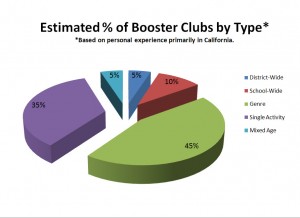 When it comes to booster clubs, size matters. I don’t mean the amount of people it serves, or volunteers it has, but rather the size and type of “turf” that it covers. Is the booster club responsible for an entire district? An entire school? The answer tells me right away many of its strengths and challenges. That’s because booster clubs usually find themselves covering one of the following 4.5 scopes of turf. (Yes, there is one that’s only half different than the other 4.) And there are a few issues that play out at each level: overhead (in volunteer time), potential competition between booster clubs, responsiveness to club needs, volunteer recruitment, and perceived adherence to Title IX (see #1 and #4). Understanding the implications of a booster’s turf will not only help you articulate challenges you face, but also assist in your search for solutions.
When it comes to booster clubs, size matters. I don’t mean the amount of people it serves, or volunteers it has, but rather the size and type of “turf” that it covers. Is the booster club responsible for an entire district? An entire school? The answer tells me right away many of its strengths and challenges. That’s because booster clubs usually find themselves covering one of the following 4.5 scopes of turf. (Yes, there is one that’s only half different than the other 4.) And there are a few issues that play out at each level: overhead (in volunteer time), potential competition between booster clubs, responsiveness to club needs, volunteer recruitment, and perceived adherence to Title IX (see #1 and #4). Understanding the implications of a booster’s turf will not only help you articulate challenges you face, but also assist in your search for solutions.
1) District-Wide:
It is rare, but some school districts mandate one umbrella booster for all organizations.
-
Parents from all associated schools serve as volunteers.
-
Ticket sales might be collected at the district level, and allocated back to schools.
-
Due to the large size, activities can share staff, such as coaches, theater directors, or conductors.
-
Individual clubs or departments from those schools then apply for grants from the booster club.
-
Thanks to this centralization, district officials can easily ensure that funding doesn’t violate Title IX. That is, it doesn’t violate the federal law, Title IX, by creating an imbalance of programming between boys and girls.
-
District-wide jurisdiction also avoids the problem of inter-school or inter-booster club competition (see #4).
-
However, a district-wide booster club comes with a fair amount of bureaucracy. Its structure is disadvantageous for volunteer recruitment or quick response to funding needs.
2) School-Wide:
A school-wide umbrella club avoids fundraising competition between groups and strikes a balance between bureaucracy and approachability.
-
Clubs still usually apply for grants, but at least they don’t have to go outside their school.
-
As with a district-wide umbrella, the potentially large pool of donors allows the booster club to embark on larger capital campaigns for facility retrofits, etc.
-
Similarly, a single school can share staff between programs, such as a medical professional or fitness staff.
- For parents with multiple kids in multiple activities, this allows them to focus their efforts rather than juggling.
-
Lastly, Volunteer recruitment is grounded in the school’s social nights and newsletters.
3) Mixed Activities, the Genre Booster (e.g. athletic, academic or arts):
Gaining popularity and possibly the most common.
-
Umbrellas organized by genre respond well to activity needs because they can gain critical mass without getting too distracted,
-
Don’t demand a wide range of expertise, and
-
Can focus on a few key staff liaisons.
-
Recruitment not only happens through the school, but also through staff leaders such as athletic directors or theater teachers.
4) Single Activity:
What you might think of as a “regular” booster club supports a single activity.
-
It brings together parents whose kids all participate in an extracurricular activity together.
-
It’s easy to connect volunteers’ efforts to a child’s well being.
-
Meetings and board member activities are efficient, because they only have one club to think about. They do have unique challenges, however.
-
It’s difficult, for example, for single activity booster clubs to know what’s going on with other organizations. When they do a fundraiser, are they copying another booster club or charity and confusing donors in the process? This happens, and it hurts feelings as well as fundraising.
- Some extracurricular activities are seasonal which can create challenges for sustaining participation in the booster club or challenges getting folks involved early in the year.
-
Another perceived problem with being disconnected from other organizations is adherence to Title IX. If, for example, a girls’ softball team out-fundraises the boys’ baseball team, they might put their school in danger of losing federal funding. (Experts tell us that you don’t have to match funds dollar-for-dollar, but you do need to be aware of how compliance is evaluated. More on this in another post soon.)
4.5) Mixed-Age:
Somewhere between a mixed activity club, a district umbrella, and a single activity club lies mixed-age booster clubs.
- Parents of students in different age groups work together.
- Despite having children on different teams, often in different schools, there seems to be a potential here for synergy between volunteers.
- Board members can stay on for more than 4 years if their kids start young, and volunteers can swap volunteer shifts without getting out of their comfort zone with an unrelated booster club.
- In many ways, they’re very similar to single activity booster clubs.
Mixed-age clubs are often able to involve a parent before there are a lot of competing kid-oriented volunteer activities and parents will “pay it forward” with their volunteering. Some clubs even formalize this with a volunteer credit system… basically allow for parent’s credits, their points for volunteering, to “spill over,” for example to their child’s high school club after they finish middle school.
There are advantages and disadvantages to size and scope of any booster club.
For existing booster clubs framing challenges in the context of a turf type helps illuminate problems and find corresponding solutions. When starting a new club, awareness of the possible sizes and shapes of booster clubs informs decisions about forging the club’s mission. For example, it is easier to start a single activity booster club, but always worth exploring a possible umbrella. I broke booster clubs into categories so that I could discuss them in this post. And I think that they reflect the reality of the many booster clubs I’ve visited with. But remember that there’s a great deal of integration between these levels. It’s common, for example, for a single club to fundraise on its own (this usually isn’t tax deductible), but ask for grants from an umbrella club at the school or district level.
What type of booster club do you work with? Is it significantly different than the 4.5 types listed here? What would you say are the biggest advantages or challenges corresponding with the size of your booster club? Let me know.




Have you ever heard of a club that supports a genre across multiple schools within a district, but not the whole district? LAUSD is huge! I’m looking for a way to support arts programs in the schools in my own hood (not the other side of the county) because they really need it. I feel like an inter-school booster club that supports arts education in elementary, middle and high schools would benefit from the long term involvement of parents where zoning overlaps differ. I am considering starting such an organization but would obviously benefit from seeing if it’s been done before.